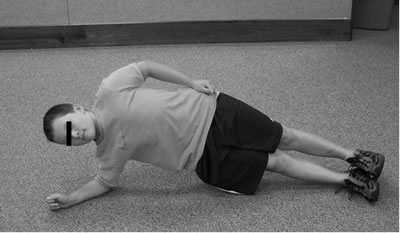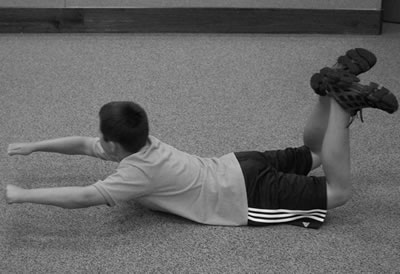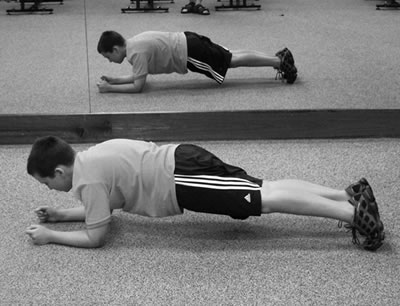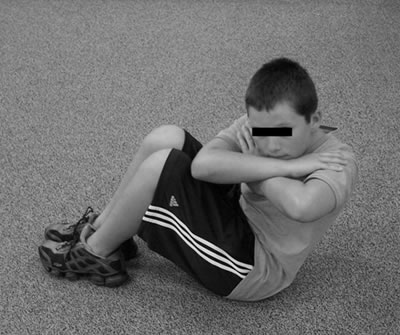|
C-hildren
O-riented
R-eally
fun E-xercises:
A Practical Core Strengthening
Program for Elementary Physical Education
Written by: Heather R.
Adams-Blair and Gretchen
D. Oliver
In Merriam-Webster Dictionary, core
is defined as, ‘the central, innermost,
or most essential part of anything’.
One would think that this definition
would be the reason for the popularity
and increasing number of core strengthening
programs, books, classes and equipment.
However, in our ever-growing society,
we still are motivated by words like
six-pack, washboard stomach, rock-hard
abs. Traditionally, we have used exercises
like sit-ups and crunches as the only
means to strengthen the core muscles
of the body to attain the results of
an aesthetically pleasing area of the
torso. Since the term core is synonymous
with a foundation, it is imperative
that we understand what the core is
in the body and its importance and function.
The body operates
as one unit, not in isolation. The core
is the body’s center of all the
bodies movements. It is important to
remember that the core is always working
as a stabilizer or actively contracting
in almost every movement the body makes.
It also acts as an anchor that the limbs
attach to either directly or indirectly
(ezinearticles.com).
The core is
considered the lumbo-pelvic-hip complex.
It is composed of the hip, trunk/lower
back (spine) and the pelvis. There are
29 muscles attached to the complex.
These muscle groups are responsible
for maintaining the stability of the
spine and pelvis. A strong core allows
a person to perform activities of daily
living with greater ease, improve sports
performance through a more effective
energy transfer from large to small
body parts, and decreases the incidence
of low-back pain (Hoeger
& Hoeger, 2008). A good training
program of core stability also contributes
to improved postural control; ensures
appropriate muscular balance and joint
movement around the lumbo-pelvic-hip
complex. In addition, the core is the
proximal stability for efficient lower
extremity mobility.
The standard
of fitness and wellness for most of
the normal population are athletes.
Many athletes have developed strength,
power and muscular endurance in specific
muscles that enable them to perform
functional activities. However, few
athletes have developed the muscles
required for stabilization of the spine
(Prentice, 2003).
The body’s stabilization system
(core) has to be functioning to effectively
utilize the strength, power and endurance
developed. If the core is unstable then
the functions of the extremities are
limited. No matter how strong the extremities
are, if the core is weak or unstable
then efficient force cannot be transferred
to the extremities in attempt to perform
optimally efficient movements. A weak
core is a fundamental problem of inefficient
movements that leads to injury (Prentice,
2003). So, what does that have
to do with the children who are enrolled
in physical education classes throughout
our society?
There has been
an increase in the frequency of injuries
in youth over the last couple of decades.
This increase in injury rate is a direct
result of the increased participation
of youth in sports. Each year in the
United States, an estimated 20 to 30
million youths between 5 and 17 years
of age participate in community sponsored
athletic programs (Leetun,
Ireland, Willson, Ballantyne & Davis,
2004; Micheli, Glassman & Klein,
2000; Myer, Ford, Palumbo & Hewett,
2005). The likelihood of injury
is inherent in any sport at any age.
So, children, regardless of sport or
activity, need to have a strong core
to create and maintain strength within
their body. There are numerous well
established risk factors for youth musculoskeletal
injuries (Patel
& Nelson, 2000; Pope, Herbert, Kirwan
et al., 2000; Prentice, 2007).
Improper body mechanics tend to be the
leading cause of many youth injuries.
Zazulak (2008) recently described upper
body control as a factor to reduce the
risk of injury in the adult.
Traditionally,
youth lack proper postural control.
On the court or field they appear as
if they are out of control. Thus, it
is only a matter of time before an injury
is suffered as a result of participation
in physical activity where proper body
control cannot be demonstrated. For
youth to develop efficient biomechanical
function of both the upper and lower
extremity it is essential to maintain
a strong and stable core. The musculature
that controls the core is critical for
trunk stabilization and efficient movement
of both the upper and lower extremity.
If a youth's core becomes weak, then
both the upper and lower extremities
must overcompensate in an attempt to
deliver the same force production as
would be available if the core were
strong.
Current evidence
suggests that decreased core stability
may predispose one to injury resulting
from over compensation of the extremities
(Wells & Bell,
1995; Wilkins, 1980; Wilson, Dougherty,
Ireland & Davis, 2005; Wyatt &
Beattie, 1995; Zito, 1983). However
with appropriate intervention of core
stabilization exercises, we may reduce
susceptibility to injury.
Previous research has shown that through
an intervention program of implementing
a core stability program into physical
education classes that were held twice
a week using four core stability exercises
held for thirty seconds each (Figures
01-04) significantly changed the participants’
ability to perform the one minute timed
sit-up test (Oliver
& Adams-Blair, 2007). The
one minute sit-up test is used to evaluate
core musculature endurance. This program
was just a matter of adding a few new
exercises into the regular routine.
There is no extra equipment needed and
it takes very little time to add to
the beginning of the physical education
class.
A good core strengthening program
in physical education classes can develop
functional fitness in our youth that
is essential to both daily living and
regular activities. As teachers begin
to think about implementing programs
into school, remember to make it fun!
Based on research by Oliver and Adams-Blair
(2007), students using the exercises
seen in the figures reported more enjoyment
with the alternative program than the
typical sit-ups. And, who knows, this
may lead to a whole generation of people
who display that six-pack and washboard
stomach.
Figure
Legend:
Figure 01: Side plank.
Figure 02: Front plank.
Figure 03: Flying squirrel.
Figure 04: Twist curl.
Figure
01: Side plank

Figure 03: Flying squirrel

|
Figure 02: Front plank

Figure 04: Twist curl

|
references
Heather
R. Adams-Blair is the Director of Graduate
Studies in the Department of Exercise
and Sport Science at Eastern Kentucky
University, 224 Moberly, 521 Lancaster
Avenue, Richmond, KY 40475. Heather.adams-blair@eku.edu
Gretchen D.
Oliver is the Clinical Coordinator of
the entry-level Graduate Athletic Training
Education Program at the University
of Arkansas and is an Assistant Professor
in the Department of Health, Kinesiology,
Recreation, and Dance, University of
Arkansas, Fayetteville, AR. Gretchen
D. Oliver 309 HPER University of Arkansas,
Fayetteville, AR 72701. goliver@uark.edu
All correspondence
to be directed:
Gretchen D. Oliver, PhD, ATC, LAT
309 HPER University of Arkansas
Fayetteville, AR 72701
O: 479.575.4670
F: 479.575.5778
goliver@uark.edu
|



